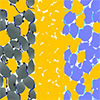| Mar 06, 2023 |
|
(Nanowerk News) In our quest for clean energy and carbon neutrality, all-solid-state lithium-ion batteries (ASS-LIBs) offer considerable promise. ASS-LIBs are expected to be used in a wide range of applications including electric vehicles (EVs). However, commercial application of these batteries is currently facing a bottleneck—their output is reduced owing to their high surface resistance.
|
|
Moreover, the exact mechanism of this surface resistance is hitherto unknown. Researchers have alluded it to a phenomenon called the “electric double layer” (or EDL) effect seen in colloidal substances (which are microscopic dispersions of one kind of particle in another substance).
|
|
The EDL effect occurs when colloidal particles gain negative electric charge by adsorbing the negatively charged ions of the dispersion medium on their surface. “This occurs at the solid/solid electrolyte interface, posing a problem in all-solid-state lithium batteries,” explains Dr. Tohru Higuchi, Associate Professor at Tokyo University of Science (TUS).
|
|
Dr. Higuchi, along with colleagues Dr. Makoto Takayanagi from TUS, and Dr. Takashi Tsuchiya and Dr. Kazuya Terabe from National Institute for Materials Science in Japan, has devised a novel technique to quantitatively evaluate the EDL effect at the solid/solid electrolyte interface.
|
|
An article detailing their technique was published in Materials Today Physics (“Accelerated/decelerated dynamics of the electric double layer at hydrogen-terminated diamond/Li+ solid electrolyte interface”).
|
 |
| Investigating the EDL effect at the solid electrolyte interface by a novel technique, researchers tuned switching response time and achieved carrier modulation at the interface between a hydrogen-terminated diamond (H-diamond) and a Li+-conducting solid electrolyte/solid interface. (Image: Tohru Higuchi from Tokyo University of Science)
|
|
The researchers employed an all-solid-state hydrogen-terminated diamond (H-diamond)-based EDL transistor (EDLT) to conduct Hall measurements and pulse response measurements that determined EDL charging characteristics.
|
|
By inserting a nanometer-thick lithium niobate or lithium phosphate interlayer between the H-diamond and lithium solid electrolyte, the team could investigate the electrical response of the EDL effect at the interface between these two layers.
|
|
The electrolyte’s composition did, indeed, influence the EDL effect in a small region around the electrode interface. The EDL effect was reduced when a certain electrolyte was introduced as an interlayer between the electrode/solid electrolyte interface. EDL capacitance for the lithium phosphate/H-diamond interface was much higher compared to the lithium niobate/H-diamond interface.
|
|
Their article also explains how they improved the switching response time for charging ASS-EDLs. “The EDL has been shown to influence switching properties, so we considered that the switching response time for charging ASS-EDLs could be greatly improved by controlling the capacitance of the EDL. We used the non-ion-permeable property of diamond in the electron layer of the field-effect transistor and combined it with various lithium conductors,” Dr. Higuchi narrates.
|
|
The interlayer accelerated and decelerated the EDL charging speed. The electrical response time of the EDLT was highly variable—it ranged from about 60 milliseconds (low speed switching for lithium phosphate/H-diamond interface) to about 230 microseconds (high speed switching for lithium niobate/H-diamond interface). The team, however, exhibited control over the EDL charging speed for over two orders of magnitude.
|
|
In summary, the researchers were able to achieve carrier modulation in all-solid-state devices and improved their charging characteristics. “These results from our research on the lithium-ion conductive layer are important for improving the interface resistance and may lead to the realization of all solid-state batteries with excellent charge-discharge characteristics in the future”, notes an optimistic Dr. Higuchi.
|
|
Taken together, this is a major steppingstone towards controlling the interface resistance of ASS-LIBs that catalyzes their feasibility for many applications. It will also help design better solid-electrolyte-based devices, a class of gadgets which also includes neuromorphic devices.
|


